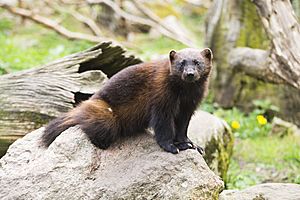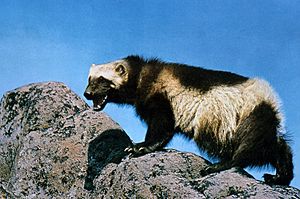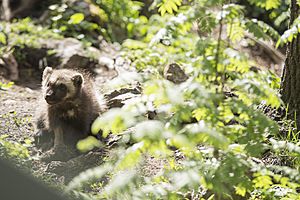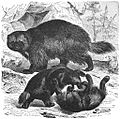Wolverine facts for kids
Quick facts for kids Wolverine |
|
|---|---|
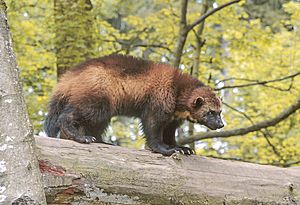 |
|
| Conservation status | |
| Scientific classification | |
| Genus: |
Gulo
|
| Species: |
gulo
|
| Subspecies | |
|
G. g. luscus |
|
 |
|
| Wolverine ranges | |
| Synonyms | |
|
Mustela gulo Linnaeus, 1758 |
|
The wolverine or glutton (Gulo gulo) is the largest animal in the weasel family. It is a strong and muscular animal that looks more like a small bear than other weasels. Wolverines live alone and are known for being very tough. They are powerful hunters and also eat dead animals they find.
Contents
Physical Characteristics of Wolverines
Wolverines are stocky and muscular animals. They have short legs, a wide, rounded head, small eyes, and short, round ears. This makes them look more like bears than other weasels. Even with short legs, their large paws have five toes and strong, crampon-like claws. This helps them climb easily over steep cliffs, trees, and snowy peaks.
An adult wolverine is about the size of a medium dog.
Wolverine Fur and Markings
Wolverines have thick, dark, oily fur. This fur is very good at keeping water out, which means it resists frost. Because of this, hunters and trappers have traditionally used wolverine fur to line jackets and parkas in very cold Arctic places. Some wolverines have a light, silvery mask on their face. A pale stripe runs from their shoulders along their sides and crosses their rump, just above their bushy tail. This tail is about 25 to 35 centimeters (10 to 14 inches) long. Some wolverines also have white patches of hair on their throats or chests.
Like many other weasels, wolverines have strong scent glands near their rear. They use these glands to mark their territory and to send signals to other wolverines about mating. The strong smell from these glands has given them nicknames like "skunk bear" and "nasty cat."
Special Teeth for Tough Food
Wolverines, like other weasels, have a special upper tooth in the back of their mouth. This tooth is turned 90 degrees towards the inside of their mouth. This unique feature helps wolverines tear meat from prey or dead animals, even if the meat is frozen solid.
Where Wolverines Live
Wolverines mostly live in isolated, cold, and mountainous areas. These include northern Canada, Alaska, Siberia, and Scandinavia. They also live in parts of European Russia, the Baltic countries, northeast China, and Mongolia.
In the United States, wolverines are found in small numbers in the Rocky Mountains and the northern Cascades. They have even been seen as far south as Michigan. In 2008 and 2009, wolverines were seen in the Sierra Nevada near Lake Tahoe for the first time since 1922. However, most wolverines in the New World (North and South America) live in Canada.
What Wolverines Eat
Wolverines eat almost any type of food they can find. Their diet includes mice, rats, birds, and bird eggs. They also hunt larger animals like reindeer. Wolverines prefer to hunt bigger prey in winter. The deep snow slows down their prey, which gives the wolverine an advantage. Wolverines have a keen sense of smell and can find prey up to 20 feet (6 meters) under the snow.
Wolverine Life Cycle and Reproduction
Wolverines are very territorial animals. Female wolverines usually reproduce every two or three years. They give birth to one to three young, called kits. The kits are born in a special tunnel called a den, which is dug deep underneath snowdrifts.
Protecting Wolverines
Humans are the main threat to wolverines. The wolverine's thick, warm fur is used to make the trim for parka hoods and other winter clothes. This is because the dense guard hairs of their fur do not collect frost.
In February 2013, the United States Fish and Wildlife Service suggested giving wolverines special protections under the Endangered Species Act. This was mainly because climate change (also known as global warming) is shrinking their snowy homes in the northern Rocky Mountains.
Images for kids
-
Wolverine skull from the Pleistocene era in Germany, displayed at the Natural History Museum, Berlin
-
A wolverine with its prey in Finland
See also
 In Spanish: Glotón para niños
In Spanish: Glotón para niños



